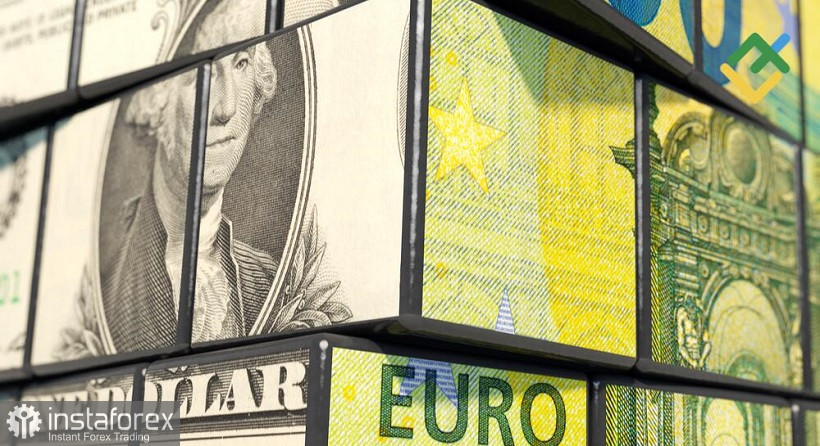The euro-dollar pair updated another price low on Friday, dropping to around 1.0073. Parity is already within easy reach, a few dozen points. And the closer this key support level is, the more cautious traders are. The impulsive spurt on Friday was replaced by the same impulsive rally – in just an hour, the price made a 100-point path along the "down-up" trajectory. Market participants are rightfully afraid of catching the price bottom, given that the pair is trading in the area of 20-year lows.

And yet, the downward trend is still in force, despite all the fears of traders. The dollar is in high demand due to two main factors: the growth of anti-risk sentiment in the markets and the strengthening of hawkish expectations regarding the further actions of the Federal Reserve. The worsening gas crisis in Europe, as well as the Nonfarm report only added to the already existing fundamental picture.
The latest data on the US labor market did not disappoint investors. The June figures came out either at the level of forecasts or in the green zone, exceeding the forecast levels. Looking ahead, it should be noted that this result increased the likelihood of another interest rate hike by 75 basis points. Even before the release, markets were estimating the likelihood of a 75-point advance in July at 88% (according to CME data).
But back to Nonfarm. The US unemployment rate remained at 3.6%. At the same mark, the indicator was released in May and April. This is a very good result. The indicator was at 3.6% in February 2020 (that is, before the coronavirus crisis), and before that, 53 years ago, back in 1969. Therefore, it is impossible to talk about any "negative trends" here, although experts predicted a stronger result. For the third consecutive month, analysts expect the index to fall to 3.5%, and for the third consecutive month it remains at the same level of 3.6%.
The number of people employed in the non-agricultural sector increased by 372,000 in June (in May, the figure was 384,000), while experts expected to see this indicator much lower, at around 260,000. Over the past four months, this component has fluctuated in the range of 372-390,000. That is, in general, this indicator did not disappoint and even exceeded the forecast estimates. As well as the indicator of growth in the number of employed in the private sector, which similarly came out in the green zone - instead of the projected growth of 200,000, it increased by 380,000.
A separate line should be said about salaries. The growth rate of the average hourly wage came out at around 5.1% (against the forecast of a decline to 5.0%). This is also a good result - over the past six months, this indicator has been fluctuating in the range of 4.9%-5.3%, so the June growth looks quite acceptable.
The report released on Friday allows the Fed to raise rates by 75 points without regard to the US labor market. The Nonfarm data did not disappoint, and in the current situation, perhaps, this is quite enough to make such a decision. For example, another Fed spokesman, Rafael Bostic, said that he "fully supports" another 75 basis point rate hike at the July meeting. Prior to this, similar statements were made by Loretta Mester, Michelle Bowman, John Williams.
However, we should admit that the dollar is gaining momentum mainly due to increased anti-risk sentiment in the markets. At the forefront of the attack is Europe, which is hit hard by the rise in prices of imported energy carriers and their shortage. Wholesale electricity prices in Germany and France have already set historic records. And not only because of the reduction in gas supplies from the Russian Federation - LNG supplies from the United States also decreased by 60 million cubic meters due to a fire at the Freeport plant. Deliveries of Russian pipeline blue fuel decreased by approximately 150 million cubic meters per day.
Against this background, the coronavirus reminded itself quite inopportunely. There is now a new wave of COVID-19 cases in many states across Europe. According to specialists from the European profile agency, the surge in incidence is caused by two mutations of the Omicron variant, which are easily transmitted from person to person. Disappointing news comes from China: the authorities are again tightening quarantine measures in several major cities in China.
Thus, the existing fundamental background contributes to the further strengthening of the US currency. But here it is necessary to pay attention to the rapid corrective rebound of the price, as soon as the pair crossed the support level of 1.0100. Traders are afraid to keep short positions below this target, as there is the notorious parity ahead. This is a powerful psychologically significant price barrier, overcoming which will be a real test for the EUR/USD bears.
Therefore, it is advisable to enter short positions only on corrective rollbacks, with targets of 1.0150 and 1.0100.
 English
English 
 Русский
Русский Bahasa Indonesia
Bahasa Indonesia Bahasa Malay
Bahasa Malay ไทย
ไทย Español
Español Deutsch
Deutsch Български
Български Français
Français Tiếng Việt
Tiếng Việt 中文
中文 বাংলা
বাংলা हिन्दी
हिन्दी Čeština
Čeština Українська
Українська Română
Română

